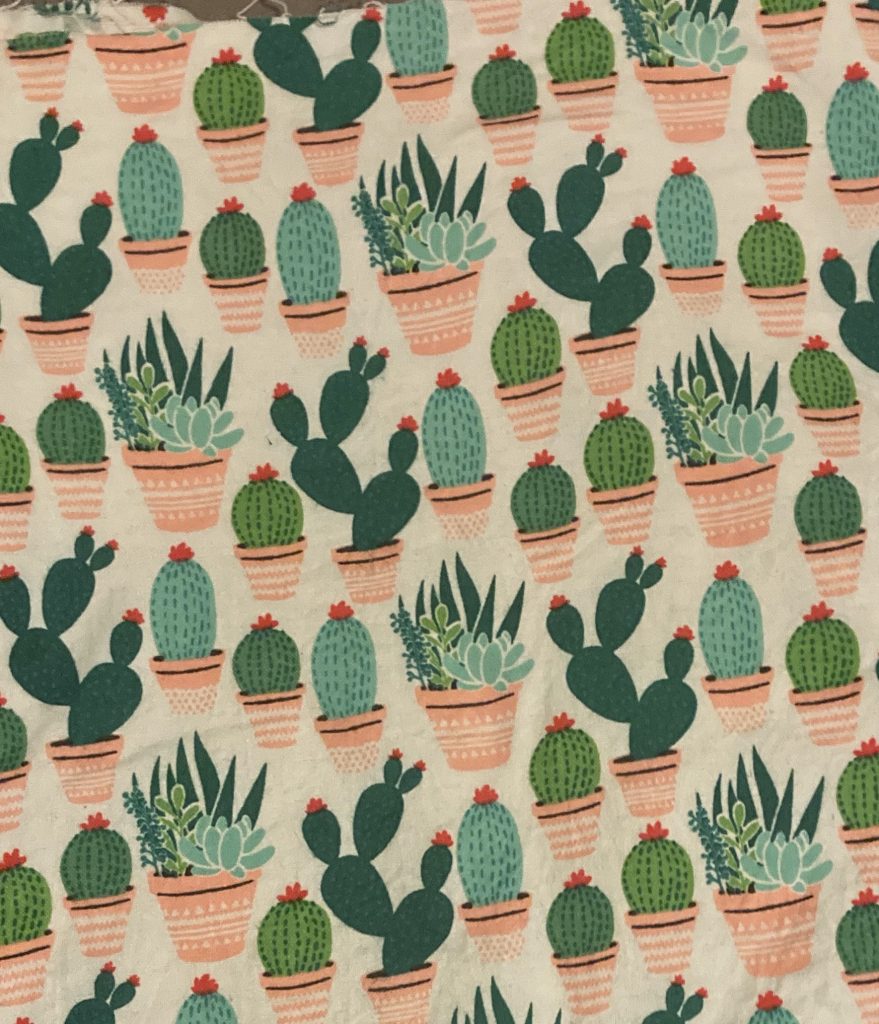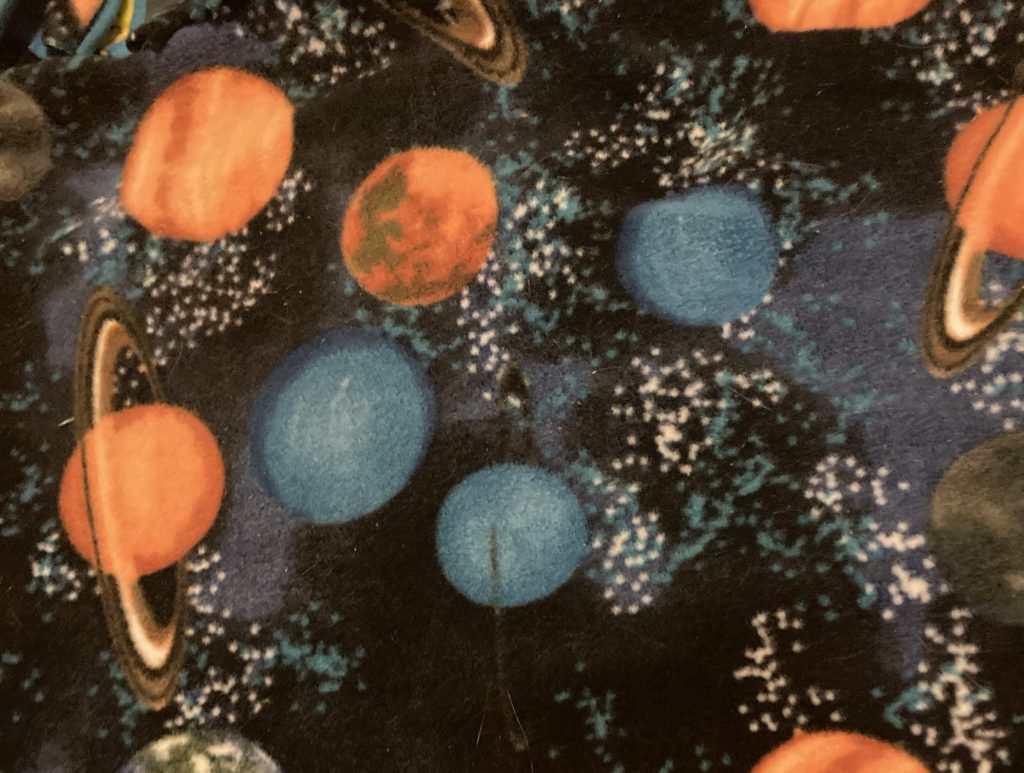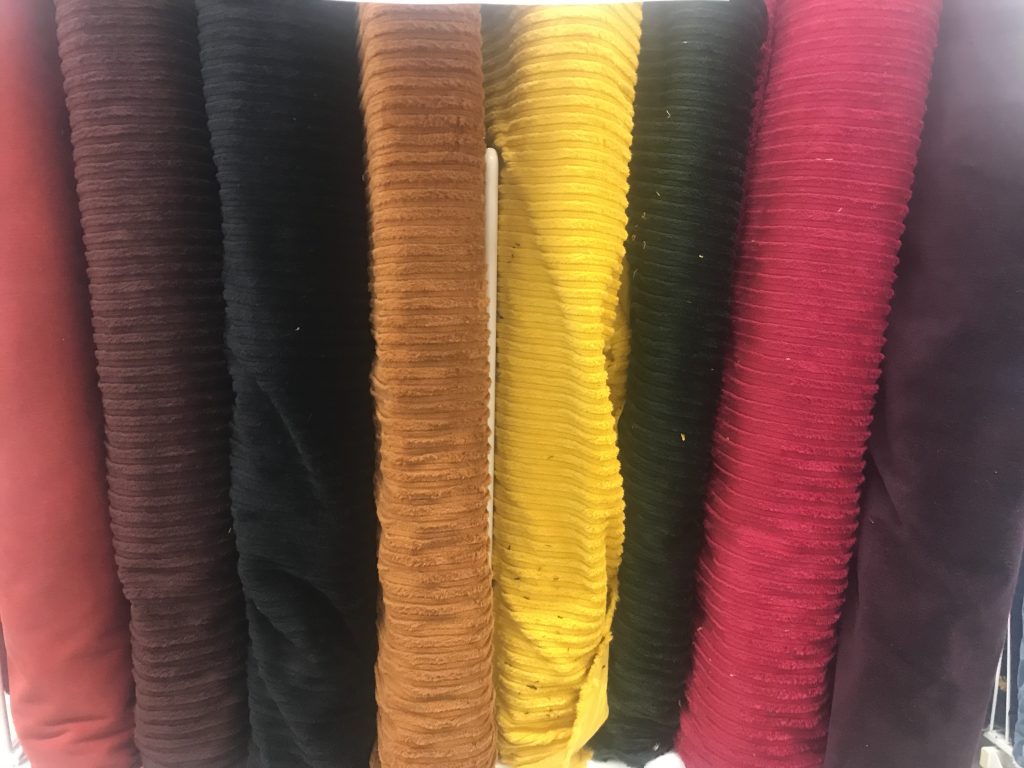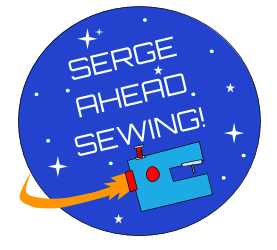General Notes:
- I am in no way endorsed by any of the companies or brands I talk about. This information comes from my own experience unless otherwise stated.
- When I refer to a “small fabric store” I’m likely referring to something like the fabric aisle of Walmart. A “large fabric store” is an actual fabric store chain, such as Jo-Ann Fabrics.
- Always read the actual instructions that come with your fabric in regards to washing and/or ironing. This advice is meant to be general.
- The price ranges are based off of the prices I’ve seen in a larger, chain fabric store (such as Jo-Ann’s). It may not be accurate to where you live. Fabric price can also vary greatly since there’s often many different types.

Flannel ~ A Softer Variation of Cotton
What can it be used for?
Flannel is basically fuzzy cotton. It comes in a pretty big variety of colors and prints, while also being soft! It’s commonly used for pajamas or blankets. A lot of baby stuff is made out of this since it’s thinner than fleece but softer than cotton!
Does it stretch?
Little to no stretch.
Does it fray or pill?
Fraying and pilling can both be issues since it’s fuzzy.
General price range
Usually around $10/yd, but many stores put it on sale pretty often.
How accessible is it?
Smaller stores may only have a small selection, but stores that have the room tend to have a lot. The variety is comparable to that of cotton.
How difficult is it to work with?
Flannel is really thin and handles a lot like cotton. It’s great for hand or machine sewing! It’s not slippery, but it is fuzzy, which may make a small mess.
Washing & Ironing Tips
Really easy to wash! Flannel doesn’t wrinkle as easily as some, but it should probably be ironed on the wrong side to be safe.

Fleece ~ The King of Tie-Blankets
What can it be used for?
Fleece is a super soft, thick, fluffy fabric that makes amazing blankets (especially “tie blankets”). Winter clothes may include fleece since it is so warm and soft. Higher end stuffed animals may be made out of this. There’s surprisingly a lot of printed options, which is what makes it a popular choice for customized blankets.
Does it stretch?
It does have a little bit of stretch, but if you stretch it too much it might not un-stretch.
Does it fray or pill?
Fleece doesn’t fray, but it can absolutely pill since it’s so fluffy. However, there is “anti-pill” fleece out there which takes care of that issue!
General price range
Fleece starts at around $10/yd, but increases with quality. Printed fleece, or fancier kinds like “luxe” fleece (which is somehow even fluffier?) can be closer to $20/yd or even more.
How accessible is it?
Fleece is extremely popular, probably right behind cotton. The popularity of fleece projects is growing since it often doesn’t include sewing! Tie blankets are extremely popular since they’re easy to make and customizable. They also don’t fray and are really comfortable.
How difficult is it to work with?
Fleece is thick stuff, so many machines may struggle with it (especially in multiple layers). It’s surprisingly not too hard to hand sew, however. It’s not necessarily that it’s tough, it’s just dense with fluff. It’s not very slippery though and doesn’t fray, which is nice.
Washing & Ironing Tips
Fleece can be washed, but it tends to be bulky in the washing machine. It’s best to skip detergent since it may mess with the coating of the fleece fibers. It may need to be dried a little longer since it’s so dense. Fleece really shouldn’t be ironed since it can melt. It’s also pretty hard to wrinkle.

Felt ~ Fuzzy Construction Paper
What can it be used for?
Felt is extremely cheap fabric that doesn’t fray and is perfect for crafts. It’s basically soft construction paper since it’s so cheap and versatile! It comes in a ton of different colors, and occasionally a few textures or prints. A lot of small stuffed animals use felt. It’s perfect for kid crafts. It’s even great for embroidery projects.
Does it stretch?
It doesn’t so much stretch as it does pull apart. If you tug really hard, it could rip in half.
Does it fray or pill?
It doesn’t fray but it does sometimes pill. Thicker, stiffer kinds may be a little more resistant.
General price range
So cheap! Usually less than a dollar for a sheet of it. The standard size of a sheet of felt is 9×12″ but it can be bought off a bolt as well.
How accessible is it?
Easy to find not only at fabric stores, but most stores with a craft section. Although it can be found on a bolt, most felt is pre-cut into rectangular sheets.
How difficult is it to work with?
Felt is very thin and soft and is perfect for hand sewing. It’s easy enough for machine sewing too, but felt is also great for details that may be a little too small to sew on a machine. It’s not slippery but it may shift a little if layered.
Washing & Ironing Tips
Easy to wash, but it is delicate. Some types of felt (recycled) can’t be ironed, but most should be ok as long as you’re careful. Always read the instructions whenever you can.

Red ~ Pixaby Image
Velvet ~ Cake is Envious of it
What can it be used for?
Velvet is a soft fabric that is notorious for being smooth. It can be made with natural or synthetic fibers. Velvet comes in a wide variety of colors, and even textures. Crushed velvet clothes have been making a comeback for the past few years. Velvet is very special since it’s weaved in a way that creates a “pile” effect, giving it its signature fuzziness.
Does it stretch?
Little to no stretch.
Does it fray or pill?
It depends on the blend, but both can be an issue. Some of the cheaper versions pill like crazy.
General price range
The price of velvet varies greatly since there are so many different blends of it. Velvet with silk is considered one of the more expensive combinations, and can be upwards of $100/yd. A cheaper version of velvet may be blended with cotton.
How accessible is it?
High quality blends are hard to come by. Cheaper blends, such as the crushed velvet kind, are found in many chain fabric stores.
How difficult is it to work with?
Velvet is thin and smooth, making it not too difficult to hand or machine sew. Some types can be slippery, but it really depends on the blend.
Washing & Ironing Tips
Velvet can be pretty delicate, so it needs to be washed with care in a machine, or by hand. It should not be ironed since it can damage and melt the “pile” effect used to create the fabric.

Corduroy ~ Teddy Bears to Trousers
What can it be used for?
Corduroy is recognized for its distinctive look; rows upon rows of little “cords.” I personally think of corduroy pants whenever I think of this fabric because it’s frequently used for clothing. It also makes a great jacket! It’s durable and soft enough to be appealing for apparel, without being too expensive.
Does it stretch?
Doesn’t really stretch, it could damage the cords.
Does it fray or pill?
Both are issues, unfortunately. Some blends are better than others but I’ve had several that wouldn’t stop fraying.
General price range
Roughly around $20/yd but it varies depending on the blend and color.
How accessible is it?
Larger fabric stores should have it, but the variety may not be huge. Printed versions do exist but aren’t as popular as the solids, since it is such a hit to make into clothes.
How difficult is it to work with?
Corduroy may be a little bit tougher to hand sew since it’s on the denser side. But most machines should be able to handle it no problem.
Washing & Ironing Tips
Corduroy is best when dry cleaned, but most can be washed at home. Certain garments may be at risk of shrinking or falling apart if not handled with enough care. It’s always best to iron corduroy on the backside of the fabric, without too much pressure, to try to preserve the cords on the opposite side. A lower temperature is best.

Suede ~ Pixaby Image
Suede ~ Elvis’ Feet Approved
What can it be used for?
Suede is a soft but durable fabric that gets used for clothing accessories such as shoes, purses, and gloves. It retains its shape well and is reasonably thick, making it protective and warm.
Does it stretch?
Doesn’t stretch but it does bend!
Does it fray or pill?
It doesn’t fray.
General price range
Faux suede is much easier to find and can go as low as $10/yd. Whereas real suede is typically around $40/yd.
How accessible is it?
Faux suede is much more accessible than the real kind, but is still probably only found in a large chain store.
How difficult is it to work with?
Actual genuine suede is more delicate than the fake kind. Real suede cracks and suffers damage when it gets wet. It’s thick and tough, which can make it hard to hand sew unless you have the right tools. A heavy duty machine is probably best equipped to handle sewing this.
Washing & Ironing Tips
Real suede gets permanently stained when wet, whereas faux is repellent to water. Either way, it’s not really recommended. Ironing is generally a no go since it can damage the fabric.
Coming soon… Part 3: Fancy Fabrics

